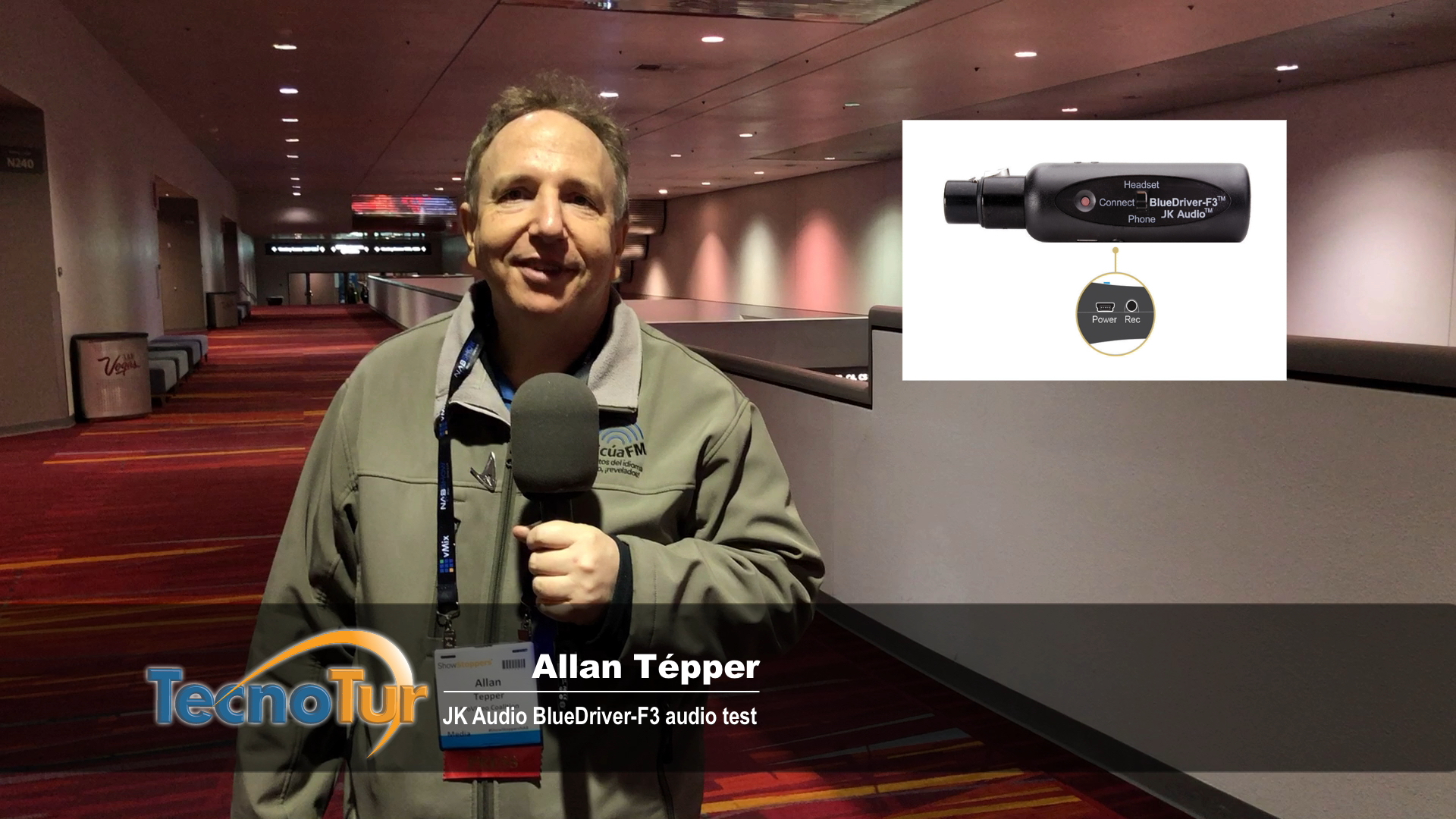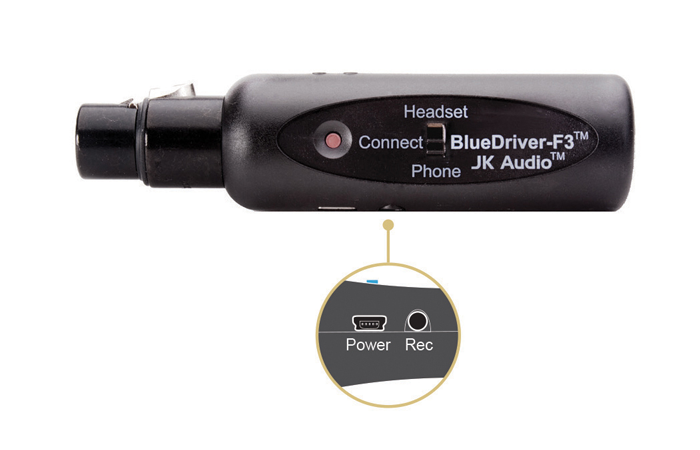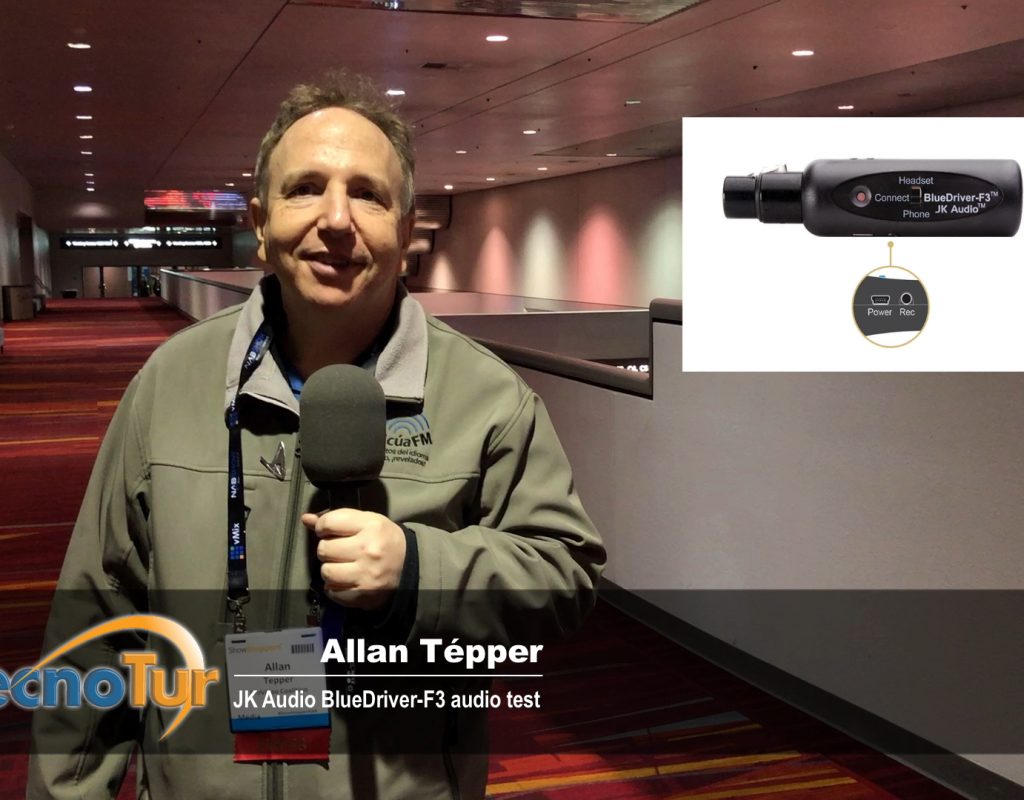
At NAB 2018 in Las Vegas, I got my first real opportunity to test JK Audio’s BlueDriver-F3 wireless Bluetooth audio transceiver for video ENG (Electronic News Gathering). In October 2017, I had published an article about using Apple’s AirPods’ mic for video production, which was truly a stretch. Unlike the AirPods (which were not designed for audio-video production), the BlueDriver-F3 and the attached handheld XLR microphone I connected to it certainly were. They allow your smartphone to be the receiver for the wireless audio transmitted to it. Ahead are two videos recordings for you to watch and listen, and plenty of commentary to read about this and other applications of the BlueDriver-F3.
In this article
- A summary about JK Audio
- A summary about BlueDriver-F3 and its Bluetooth profiles
- My initial use of the BlueDriver-F3 as a transmitter in a wireless microphone system to a smartphone (with 2 videos), where the smartphone is the receiver
- Other applications for the BlueDriver-F3
- Conclusions
A summary about JK Audio

I have known about JK Audio and its audio hybrids and other products for audio production for decades. It was founded in 1992 by Joe Klinger. Although I have not met him personally yet, we have been in email contact since 2012. I am glad he agreed to lend me a BlueDriver-F3 (Amazon — B&H) for this review, since I am so intrigued with its possibilities. The current JK Audio headquarters (shown above) is located in Sandwich, Illinois, a small town just 96 kilometers (60 miles) West of Chicago. The city of Sandwich, Illinois is named after a US town (Sandwich, New Hampshire),

which in turn was named in honor of John Montagu (1718 – 1792), a British statesman who was the 4th Earl of Sandwich, and is said to be the inventor of the sandwiches we eat.
A summary about BlueDriver-F3 and its Bluetooth profiles

The BlueDriver-F3 from JK Audio (Amazon — B&H) is a wired<>wireless Bluetooth transceiver. I am using the term transceiver, since it is actually bidirectional, meaning that it can act both a transmitter and a receiver in some applications, although in the application I have tested so far, I only used it as a transmitter, as you’ll see ahead in this article. I’ll list that last in this list, to match the numbering in JK Audio’s official BlueDriver-F3 Applications Guide:
- LIVE REMOTE (WO)MAN-ON-THE-STREET INTERVIEWS for a traditional, terrestrial AM/FM radio station or Internet radio. For this, you plug BlueDriver-F3 into the bottom of an XLR dynamic microphone (or self-powered condenser microphone), then pair to a mobile phone and dial into the station as usual for live remote broadcast to the station. This setup allows voice band, bi-directional audio to and from your cell phone. The mini cable provided with the BlueDriver allows you to connect the REC output from the BlueDriver-F3 to a portable recorder to capture a full bandwidth recording of your voice on one channel, and the return from the station on the other. The headphone output on your recorder can then provide an outlet for listening to your voice as well as the return audio from the mobile phone. This will likely work with audio códec apps and live Internet radio apps also, as long as the app can select Bluetooth as a source. Check with the particular app for Bluetooth compatibility.
- BACKUP AUDIO FOR REMOTE BROADCASTS — As stated by JK Audio: “You may have the finest IP CÓDEC available, but if the internet goes down, there goes the remote. Simply plug BlueDriver-F3 into the master audio output of your mixer or CÓDEC. Pair to your cell phone which is dialed into the station. This setup allows voice band audio, through your cell phone, back to the station. The mini cable provided with your BlueDriver allows you to connect the REC output from the BlueDriver-F3 to a mic-level 3.5 mm input on your mixer (if available) to allow for monitoring the return audio from the station.”
- RECORD PHONE INTERVIEWS — Per JK Audio: “Record high quality phone interviews using your favorite mic and headphones. Simply plug BlueDriver-F3 into the bottom of a dynamic microphone, then pair to a cell phone and place a call as usual. This setup allows voice band, bi-directional audio to and from your cell phone. The mini cable provided with your BlueDriver allows you to connect the REC output from the BlueDriver-F3 to a portable recorder to capture a full bandwidth recording of your voice on one channel, and the caller’s voice on the other channel. The headphone output on your recorder can then provide an outlet for listening to your voice as well as the return audio from the cell phone.”
- TRANSMIT BLUETOOTH A2DP AUDIO — Per JK Audio: “The ‘Headset’ mode of BlueDriver-F3 connects to Bluetooth headphones or wireless speakers, and provides full 20 kHz audio bandwidth A2DP audio. Simply plug BlueDriver-F3 into the mic-level audio output of your mixer or playback system, then pair to your headphones or speaker. Keep in mind that Bluetooth A2DP processing adds a 150 millisecond delay, so this application is more appropriate for pre-recorded or broadcast applications that do not have a live mic or interactive conversation. Also keep in mind that the 3 pin XLR is a balanced mono connection. BlueDriver-F3 sends the mono XLR signal to both left and right channels of the Stereo A2DP Bluetooth signal. A2DP is a one-way transmission, with nothing coming back on the return channel.
- AS A WIRELESS MIC TRANSMITTER FOR YOUR VIDEO SHOOT, which is the application I tested, and demonstrated ahead in this article, with two videos.
(See my opinion about these five applications in the Conclusions section of this article.)
Bluetooth profiles included in the BlueDriver-F3
- Hands-Free (Full Duplex): 300 Hz – 3.4 kHz
- Hands-Free (Full Duplex HD): 50 Hz – 7 kHz
- A2DP (unidirectional Master » Headset with 150 millisecond delay): 30 Hz– 17 kHz
So far, the two smartphone apps I know that can accept Bluetooth audio are FiLMiC Pro (covered in several articles, although so far, it seems as if FiLMIC Pro has only added Bluetooth capabilities to the iOS version, not the Android version) and Cinema FV-5 (reviewed here) for Android.
To my knowledge, so far, smartphones and tablets only use the higher-quality A2DP profile as a Master (to transmit, not to receive). I don’t know which Hands-Free profile is used by FiLMiC Pro, which is the app used by Cielo de la Paz of The Storyographist in the two videos you’ll see ahead. However, I am impressed with the voice quality for ENG applications,
especially compared with the quality I heard with Cielo’s test with Apple AirPods back in 2017 (illustrated above, Amazon ).
Initial use of the BlueDriver-F3 as a transmitter in a wireless microphone system to a smartphone
At NAB 2018, Cielo de la Paz of The Storyographist shot me with her iPhone X using FiLMiC Pro at 1080p and 48 kHz audio sampling frequency. I used the Pyle PDMIC78 dynamic microphone (reviewed here, Amazon — B&H) and the enormous Shure A81WS windscreen (Amazon — B&H). I edited the video using Telestream’s ScreenFlow version 6.2.3 (29875) which fortunately still works with macOS 10.13.4 (17E199). I exported the edited video at 1080p 20,000 Mb/s H.264 High Profile and 48 kHz audio sampling mono before uploading to Vimeo. Since Vimeo may have degraded the audio in lower resolutions, I recommend setting your Vimeo player to 1080p for best evaluation. This video has no additional illumination other than the Las Vegas Convention Center lights.
Unfiltered version
Filtered with Auphonic.com
I much prefer the quality of the filtered version by Auphonic.com. Thanks again to Cielo de la Paz of The Storyographist for shooting me with her iPhone X for this test, and thanks to Gonzalo Mendiola for the TecnoTur logo and lower third design.
Conclusions
Almost 10 years ago, my Peruvian friend Jorge Koechlin from AutoMundo.com asked me (in Castilian, the world’s most widely used Spanish language, but not the only one): “Allan, isn’t there a way to have a wireless mic that uses the smartphone’s own Bluetooth technology as the wireless receiver?”. Jorge, now there is! The first example is the BlueDriver-F3 (Amazon — B&H) from JK Audio
In my opinion, the most enticing reasons to acquire a BlueDriver-F3 are for applications 1, 2 and 5 as covered in this article, since applications 3 and 4 can be accomplished other ways at a lower cost with other equipment you may already own. However, once you acquire a BlueDriver-F3, it makes sense to use it for all possible uses when your BlueDriver-F3 is not being used for applications 1, 2 or 5. Application 5 makes sense either for live use, or when you do not have time to use dual-system audio using a system like the ingenious AirLinc app, which I covered here.
Upcoming articles, reviews, radio shows, books and seminars/webinars
Stand by for upcoming articles, reviews, and books. Sign up to my free mailing list by clicking here. Most of my current books are at books.AllanTepper.com, and my personal website is AllanTepper.com.
Si deseas suscribirte a mi lista en castellano, visita aquí. Si prefieres, puedes suscribirte a ambas listas (castellano e inglés).
Suscribe to his BeyondPodcasting show at BeyondPodasting.com.
Subscribe to his Tu radio global show at Turadioglobal.com.
Subscribe to his Tu salud secreta show at TuSaludSecreta.com.
Subscribe to his CapicúaFM show at CapicúaFM.com.
Save US$20 on Project Fi, Google’s mobile telephony and data
Click here to save US$20 on Project Fi, Google’s mobile telephone and data service which I have covered in these articles.
FTC disclosure
No manufacturer is specifically paying Allan Tépper or TecnoTur LLC to write this article or the mentioned books. Some of the other manufacturers listed above have contracted Tépper and/or TecnoTur LLC to carry out consulting and/or translations/localizations/transcreations. Many of the manufacturers listed above have sent Allan Tépper review units. So far, none of the manufacturers listed above is/are sponsors of the TecnoTur , BeyondPodcasting or TuNuevaRadioGlobal programs, although they are welcome to do so, and some are, may be (or may have been) sponsors of ProVideo Coalition magazine. Some links to third parties listed in this article and/or on this web page may indirectly benefit TecnoTur LLC via affiliate programs. Allan Tépper’s opinions are his own.
Copyright and use of this article
The articles contained in the TecnoTur channel in ProVideo Coalition magazine are copyright Allan Tépper/TecnoTur LLC, except where otherwise attributed. Unauthorized use is prohibited without prior approval, except for short quotes which link back to this page, which are encouraged!

Filmtools
Filmmakers go-to destination for pre-production, production & post production equipment!
Shop Now














